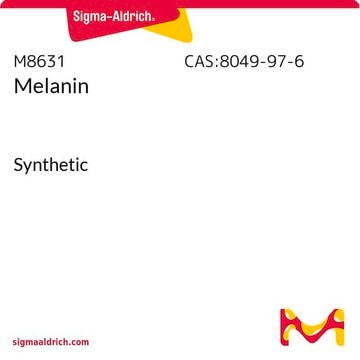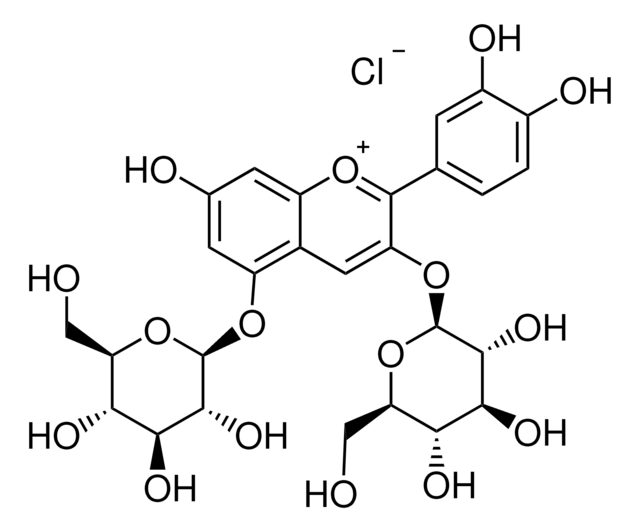If this product has an expiration or retest date, it will be shown on the Certificate of Analysis (COA, CofA). If there is no retest or expiration date listed on the product's COA, we do not have suitable stability data to determine a shelf life. For these products, the only date on the COA will be the release date; a retest, expiration, or use-by-date will not be displayed.
For all products, we recommend handling per defined conditions as printed in our product literature and website product descriptions. We recommend that products should be routinely inspected by customers to ensure they perform as expected.
For products without retest or expiration dates, our standard warranty of 1 year from the date of shipment is applicable.
For more information, please refer to the Product Dating Information document: https://www.sigmaaldrich.com/deepweb/assets/sigmaaldrich/marketing/global/documents/449/386/product-dating-information-mk.pdf
L9879
Lycopene
≥90%, from tomato
Sinônimo(s):
ψ,ψ-Carotene, 2,6,10,14,19,23,27,31-Octamethyl-dotriaconta-2,6,8,10,12,14,16,18,20,22,24,26,30-tridecaene
About This Item
Produtos recomendados
fonte biológica
tomato
Ensaio
≥90%
Formulário
powder
Condições de expedição
dry ice
temperatura de armazenamento
−70°C
cadeia de caracteres SMILES
C\C(C)=C\CC\C(C)=C\C=C\C(C)=C\C=C\C(C)=C\C=C\C=C(C)\C=C\C=C(C)\C=C\C=C(/C)CC\C=C(\C)C
InChI
1S/C40H56/c1-33(2)19-13-23-37(7)27-17-31-39(9)29-15-25-35(5)21-11-12-22-36(6)26-16-30-40(10)32-18-28-38(8)24-14-20-34(3)4/h11-12,15-22,25-32H,13-14,23-24H2,1-10H3/b12-11+,25-15+,26-16+,31-17+,32-18+,35-21+,36-22+,37-27+,38-28+,39-29+,40-30+
chave InChI
OAIJSZIZWZSQBC-GYZMGTAESA-N
Procurando produtos similares? Visita Guia de comparação de produtos
Descrição geral
Aplicação
- in high performance liquid chromatography (HPLC) to determine its concentration in liver, kidney and lung tissue[2]
- to induce urokinase plasminogen activator receptor (uPAR) IN prostate cancer cell line[3]
- in Raman chemical imaging system to detect and visualize its internal distribution[4]
Ações bioquímicas/fisiológicas
Embalagem
produto relacionado
Código de classe de armazenamento
11 - Combustible Solids
Classe de risco de água (WGK)
WGK 3
Ponto de fulgor (°F)
Not applicable
Ponto de fulgor (°C)
Not applicable
Equipamento de proteção individual
Eyeshields, Gloves, type N95 (US)
Escolha uma das versões mais recentes:
Já possui este produto?
Encontre a documentação dos produtos que você adquiriu recentemente na biblioteca de documentos.
Os clientes também visualizaram
Artigos
Cholesterol synthesis regulation by dietary levels, LDL receptors control lipid-rich LDL particle transport in cells.
All-trans retinoic acid (RA, ATRA) is a pleiotropic activation factor that regulates genes associated with normal vertebrate cellular processes such as cell differentiation, cell proliferation, apoptosis, and embryonic development.
Antioxidants protect biological systems from oxidative damage produced by oxygen-containing free radicals and from redoxactive transition metal ions such as iron, copper, and cadmium.
-
How can I determine the shelf life / expiration / retest date of this product?
1 answer-
Helpful?
-
-
How is shipping temperature determined? And how is it related to the product storage temperature?
1 answer-
Products may be shipped at a different temperature than the recommended long-term storage temperature. If the product quality is sensitive to short-term exposure to conditions other than the recommended long-term storage, it will be shipped on wet or dry-ice. If the product quality is NOT affected by short-term exposure to conditions other than the recommended long-term storage, it will be shipped at ambient temperature. As shipping routes are configured for minimum transit times, shipping at ambient temperature helps control shipping costs for our customers. For more information, please refer to the Storage and Transport Conditions document: https://www.sigmaaldrich.com/deepweb/assets/sigmaaldrich/marketing/global/documents/316/622/storage-transport-conditions-mk.pdf
Helpful?
-
-
Is Lycopene at this concetration dissolved in water for research on mice
1 answer-
No, lycopene (L9879) can't be dissolved in water. The product is for lab research only, not for animal experiments.
Helpful?
-
-
How can I assess the condition of Product L9879, Lycopene, from its appearance?
1 answer-
We advise against using the product if it becomes speckled or has a "salt and pepper" appearance. An acceptable range of colors is from dark purple to reddish brown to brown.
Helpful?
-
-
How can Product L9879, Lycopene, be dissolved?
1 answer-
Lycopene dissolves in carbon disulfide (1 g/50 mL), boiling ether (1 g/3 L), boiling petroleum ether (1 g/12 L) or hexane at 0 °C (1 g/14 L). Lycopene is almost insoluble in methanol or ethanol, but is soluble in chloroform or benzene.
Helpful?
-
-
What is the method of preparation of Product L9879, Lycopene?
1 answer-
Details of the method of preparation are considered proprietary information. The last solvent that the lycopene comes into contact with is methanol. However, the material is dried extensively, so little, if any, methanol should be present.
Helpful?
-
-
What is the solution stability of Product L9879, Lycopene?
1 answer-
A solution prepared under argon, protected from light and stored at -20 °C is stable for up to 48 hours. It is recommended to prepare solutions fresh each time and to prepare immediately before use.
Helpful?
-
-
What is the Department of Transportation shipping information for this product?
1 answer-
Transportation information can be found in Section 14 of the product's (M)SDS.To access the shipping information for this material, use the link on the product detail page for the product.
Helpful?
-
-
What is the extinction coefficient of Lycopene, Product L9879?
1 answer-
Extinction Coefficients: For samples dissolved in petroleum ether, E1% = 3450 (at 472 nm), 2250 (at 446 nm) and 3150 (at 505 nm).
Helpful?
-
-
Is Product L9879, Lycopene, of the Trans or Cis stereoforms?
1 answer-
Based on the CAS number search in ACS database and the chemicals encyclopedia published by the Royal Society of Chemistry, this lycopene is an all-trans compound. The chemicals encyclopedia published by the Royal Society of Chemistry, 12th ed., Entry# 5650.
Helpful?
-
Active Filters
Nossa equipe de cientistas tem experiência em todas as áreas de pesquisa, incluindo Life Sciences, ciência de materiais, síntese química, cromatografia, química analítica e muitas outras.
Entre em contato com a assistência técnica








